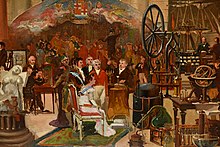Royal Barcelona Board of Trade


The Royal Barcelona Board of Trade or
History and function
After the suppression of the Consulate of the Sea and the universities under the Nueva Planta decrees, local merchants sought a new institution to regulate and support commerce, trade and agriculture and to represent them to royal authorities. It was recognised that traders needed to be trained in accounting, navigators were needed to transport products across the Atlantic, designers were needed to make the products more attractive to consumers, chemists were needed to prepare dyes and other products, technicians were needed to improve agriculture.[1]
The Board of Trade was mainly focused on improving the textile industry including securing trade protection, issuing manufacturing and guild regulations and encouraged research into manufacturing processes. It agitated for the abolition of the bubble tax in 1769 and the opening of Catalonia to American commerce in 1778. Although the Board mostly represented the interests of the big merchants, it also provided a lot of support to artisans and guilds as well as the petite bourgeoisie.[2]
The Board encouraged technical and artistic education, disseminating scientific knowledge coming from abroad, and encouraged innovation in production and trade. It established schools of sailing and navigation (1769), drawing and the fine arts (1775), shorthand (1775), trade (1787), bureau of machines (1804), chemistry (1805), botany and agriculture (1807), mechanics (1808) physics (1814) and economics (1814).[3][4] Evening classes and free drawing and engraving courses for chintz factory workers was crucial to the growth of that industry[5] and helped to consolidate Barcelona as a city of manufacturing in the mid 18th century.
Outside Barcelona, the board set up a public school of drawing in Mataró, with Joan Barba as a drawing teacher from 1841 to 1851[6]
Building
The former seat of the Consulate of the Sea in Barcelona, the : Saló de Contractacions).
See also
References
- ^ Barca Salom et al. 2009.
- ^ I. Mateo 2014, p. 121.
- ^ Pelayo 2013, p. 67.
- ^ Ruiz y Pablo 1919.
- ^ Thomson 1989, p. 90.
- ^ AMM. Municipal records, 4 November 1837 and 13 February 1852.
External links
Bibliography
- Barca Salom, Francesc Xavier; et al. (2009). Fàbrica, taller i laboratori. La Junta de Comerç de Barcelona, Ciència i tècnica per a la indústria i el comerç (1769-1851) [Factory, workshop and laboratory. The Board of Trade of Barcelona: science and technology for industry and commerce] (in Spanish). Barcelona: Cambra Oficial de Comerç, Indústria i Navegació de Barcelona. p. 372. OCLC 804768915.
- Gurrera i Lluch, Montserrat (2011). "Els Inicis de l'escola pública municipal de dibuix de Mataró i La Implicació de la Junta de Comerç de Barcelona (1815-1886)" [The Beginnings of the municipal school of drawing in Mataró and the involvement of the Board of Trade of Barcelona (1815-1886)]. Sessió d'estudis Mataronins (in Catalan). 27. Mataró: 45–47. ISSN 2385-4766.
- Ruiz y Pablo, Angel (1919). Historia de la Real Junta Particular de Comercio (1758-1847) (in Spanish). Barcelona: Henrich y Cª. p. 447.
- I. Mateo, Pilar, ed. (2014). Universitat a Cervera, La. Commemoració del 1714 a la UB (in Catalan). Universitat de Barcelona. ISBN 978-84-475-3865-2. Retrieved 2 Aug 2022.
- Thomson, J.K.J. (1989). "The Catalan Calico-Printing Industry Compared Internationally". Anuari de la Societat Catalana d'Economia. 7. Societat Catalana d'Economia: 72–95. OCLC 1233047478. Retrieved 25 July 2022.
- Pelayo, Javier Antón (2013). "The Enlightenment in Catalonia". Catalan Historical Review. 6 (6). Barcelona: Institut d´Estudis Catalans: 61–71. ISSN 2013-407X.
